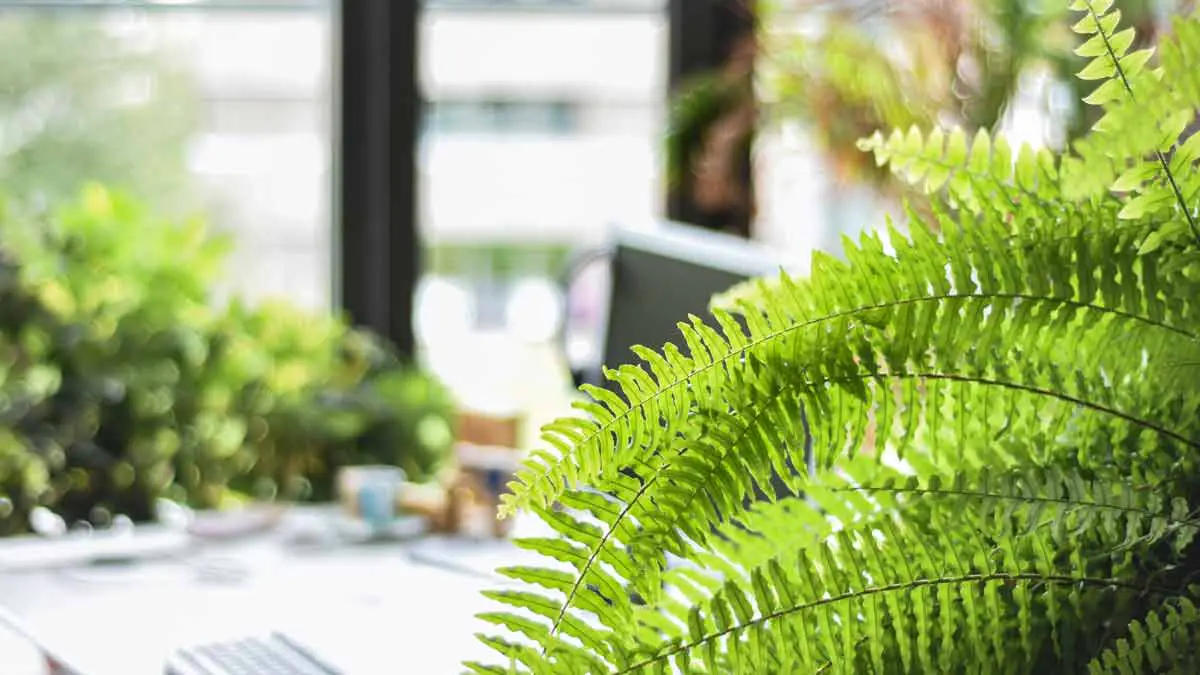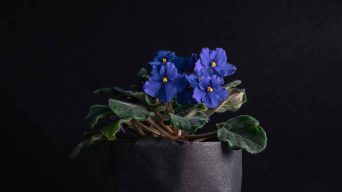Growing ferns in pots is a great way to add greenery to your space. Choose a shallow pot, at least 6 inches deep, with good drainage. Use a standard all-purpose compost or potting mix. Keep ferns in a shaded area, water them regularly, and mist them occasionally. Repot when they begin to overcrowd their container.
Are you looking to add beauty and elegance to your home or garden with the graceful presence of ferns?
You’ve come to the right place!
In this guide, we’ll walk you through growing ferns in pots, covering essential topics such as choosing the perfect fern species, selecting an ideal pot, preparing soil and planting, and effective ways to care for your potted masterpiece.
With our expert advice and practical tips, becoming a successful fern cultivator has never been easier.
Selecting And Choosing Ferns For Pots
In the world of potted plants, few are as versatile and elegant as ferns. However, selecting the perfect fern for your container requires careful consideration of several factors.
The mature size of the plant, its lighting needs, and moisture requirements are all crucial elements to ensure a flourishing and healthy fern in your potting collection.
Types Of Ferns Suitable For Pots
Growing ferns in pots provide a versatile and low-maintenance option for indoor and outdoor gardening.
Here is a list of some popular fern species that are suitable for pot cultivation:
- Boston Fern (Nephrolepis exaltata) – A classic choice known for its lush, arching fronds.
- Staghorn Fern (Platycerium) – An eye-catching species with unique antler-like fronds.
- Japanese Holly Fern (Cyrtomium falcatum) – Offers a distinctive look with its glossy, dark green leaves.
- Maidenhair Fern (Adiantum) – Delicate and airy, this fern thrives in high-humidity environments.
- Western Sword Fern (Polystichum munitum) – A hardy option that can tolerate various light conditions.
- Japanese Painted Fern (Athyrium niponicum) – Known for its stunning silver and purple foliage.
- Asparagus Fern (Asparagus densiflorus) – Though not a true fern, this plant has feathery foliage that resembles one.
- Evergreen Ferns: Hart’s Tongue Fern (Asplenium scolopendrium) or Christmas Fern (Polystichum acrostichoides) – These varieties retain their foliage year-round.
Factors To Consider When Selecting Ferns For Your Pot
Selecting the perfect fern for your pot requires thoughtful consideration of various factors to ensure a healthy and thriving plant.
Keep the following aspects in mind while choosing ferns for your container garden:
- Climate and landscape: Assess your area’s environment and whether you plan to keep the fern indoors or outdoors. This will help you select a suitable variety adaptable to your specific environment.
- Size and growth rate: Consider how large the fern will grow, and choose a type that fits comfortably within its designated space in your home or garden.
- Sunlight and shade requirements: Different fern varieties have unique light preferences, with most requiring partial shade rather than direct sunlight. Be sure to choose a fern type compatible with its intended location’s lighting conditions.
- Soil preferences: While most ferns enjoy moist soil rich in organic matter, it’s essential to determine each variety’s preferred soil type to maintain optimal growth and health.
- Watering needs: Ferns typically need consistent moisture, but different varieties may require more or less water depending on their needs. Choosing a fern suited for your watering habits can contribute significantly to its success.
- Foliage appearance: Some people prefer evergreen ferns, while others appreciate deciduous varieties that change with the seasons. Take note of each type’s foliage characteristics before committing to a decision.
- Special accommodations: Certain species, like staghorn ferns, require unique care techniques due to their distinct growing habits – decide if you are willing to meet these requirements before introducing them into your collection.
Choosing The Right Pot
As you gaze upon the delicate fronds of a fern, it’s easy to overlook its pot’s critical role in its growth.
The right pot is more than just a vessel to hold soil.
It’s a vital tool that provides the space and support necessary for a fern’s root system and fronds to flourish.
Delve into the world of fern cultivation as we explore the various pot options available and the key factors to consider when selecting the perfect container for your green companions.
Importance Of Selecting The Right Pot For Your Ferns
Selecting the right pot for your ferns ensures their healthy growth and overall well-being.
The appropriate pot size and drainage system play a pivotal role in maintaining an optimal environment for the root systems, preventing problems such as waterlogging or stunted growth.
If you attempt to grow a Boston fern in a pot that’s too small with insufficient drainage holes, the roots might become confined within limited space while excess moisture builds up around them.
This creates an ideal breeding ground for harmful fungi and bacteria, which could ultimately cause root rot – leading to your beloved houseplant’s wilted fronds or even death.
Types Of Pots Suitable For Ferns
When choosing a pot for your fern, consider that the material, size, and shape play an important role in the health and growth of your plant.
Here are some pots suitable for growing ferns:
- Plastic Pots: These pots are affordable, lightweight, and retain moisture well. They come in various colors and sizes, making them popular for growing ferns.
- Terracotta Pots: These porous clay pots allow better airflow to the roots and promote healthy growth. However, they dry out quickly, so monitor watering closely.
- Hanging Baskets: Hanging baskets allow ferns to drape down, creating a beautiful display while providing ample space for the plant’s root system.
- Wooden Planters: Wooden boxes or planters add a natural touch to your decor while providing adequate drainage and airflow around the roots.
- Ceramic Pots: These decorative pots come in many shapes, sizes, and patterns allowing you to choose one that complements your decor style while still providing good drainage for your ferns.
Remember to choose a pot at least 2 inches wider than the root ball of your fern to provide enough room for growth, and ensure it has adequate drainage holes to prevent waterlogging and root rot.
How To Choose The Right Size And Shape Of The Pot
Choosing the right pot size and shape is crucial for the growth and health of your potted ferns.
Here are some tips to help you choose the right size and shape of the pot:
- Choose a pot that is at least 2-4 inches wider in diameter than the root ball of your fern but not much larger. A pot that is too big may cause waterlogging and other problems.
- Consider the height of your fern when choosing a pot. The height of the plant should be proportional to the size of the pot it is planted in.
- Choose a deep enough pot to accommodate the root system of your fern. This will prevent overcrowding and promote healthy growth.
- Opt for pots with drainage holes to ensure proper drainage and avoid waterlogging, which can lead to root rot.
- Choose a material that suits your plant’s needs – plastic pots typically retain moisture better than clay or terracotta pots, which allow for more air circulation.
Preparing The Pot And Soil
The art of fern cultivation demands more than just a green thumb.
The key to thriving ferns lies in their meticulous living environment preparation.
Every step must be taken carefully, from selecting the optimal soil composition to carefully amending it with nutrient-rich additives.
Importance Of Preparing The Pot For Planting
Proper preparation of the pot is crucial to ensuring healthy fern growth.
Before planting, it’s essential to clean and sterilize old pots or soak new ones in water overnight.
Adding a layer of gravel or broken crockery at the bottom can help with drainage while preventing soil from clogging the drainage holes. Additionally, selecting the right size and shape of the pot is crucial – choose one that allows ample room for your fern roots to spread out but is not too large that they become overwhelmed.
To ensure optimal growing conditions, use a high-quality potting mix suited for ferns’ requirements when planting- which should be moist but not too wet- as excessive moisture may lead to rotting before consistent watering practices have been established.
Types Of Soil And Amendments Suitable For Ferns
Choosing the right soil and amendments for your ferns is crucial to their health and growth.
Here are some options to consider:
- Peat moss: This organic material has high water retention capability, making it perfect for ferns that require ample moisture.
- Perlite: Adding perlite to soil can improve air circulation and drainage, which is essential for preventing root rot in ferns.
- Compost: Incorporating compost into your potting mix can provide essential nutrients while improving soil structure.
- Coarse sand: Mixing coarse sand into the potting mix can help improve drainage and avoid waterlogging in pots.
- Pine bark: Pine bark adds acidity to the soil, a desirable quality for acid-loving ferns such as Japanese painted ferns.
Remember to avoid using heavy garden soils or clay-based soils when planting ferns in pots, as they can become compacted and hinder root growth.
Instead, opt for lighter potting mixes designed explicitly for container gardening to ensure the healthy growth of your ferns.
How To Prepare The Potting Mix And What To Avoid
Preparing the potting mix is an essential step in growing ferns in pots.
Here are some tips on how to prepare the perfect potting mix for your ferns:
- Choose high-quality soil that is well-draining and rich in nutrients.
- Avoid using heavy soils or those that have been compressed, as this can affect drainage and oxygen flow to the roots.
- Mix compost or peat moss into the soil to provide additional nutrients and improve drainage.
- Add perlite, vermiculite, or sand to the potting mix to improve its structure and prevent waterlogging.
- Avoid using garden soil, as it may contain weeds, pests, or diseases that can harm your ferns.
- Sterilize the potting mix before use by baking it in an oven at 180°C for 30 minutes or soaking it in boiling water for 15-20 minutes.
Planting Ferns In Pots
As you gaze upon the lush greenery of a fern, it’s easy to understand why they’ve become such popular houseplants.
But ensuring your beloved ferns’ optimal growth and longevity requires more than a pretty pot.
Knowing the proper steps for planting ferns in pots is essential to achieve success.
Steps For Planting Ferns In Pots
To successfully plant ferns in pots, follow these simple steps:
- Select the appropriate pot size and shape. The pot should be deep enough to accommodate the root ball, with a diameter of at least double the root ball’s width.
- Fill your pot with a well-draining potting mix that is moist but not soggy. Add some compost or peat moss if necessary to improve soil quality.
- Carefully remove your fern from its original container, not damaging the delicate fronds or roots.
- Loosen the roots around the edges of the root ball and prune any that appear brown or damaged to encourage healthy growth.
- Place your fern in the center of the pot, ensuring that it is upright and at a similar depth as it was in its previous container.
- Backfill with more potting mix, pressing down lightly to eliminate air pockets around the roots.
- Water your newly potted fern thoroughly until water runs out of the drainage holes at the bottom of your pot, then move it to an ideal location according to its light requirements.
Tips For Proper Spacing And Placement
Proper spacing and placement of ferns in pots is essential for their growth and establishment.
Here are some tips to ensure your ferns thrive:
- Space your ferns appropriately: When planting ferns in pots, provide enough space between plants to avoid overcrowding. Smaller ferns like Maidenhair fern can be spaced about 18 to 24 inches apart, while larger growing ferns like Ostrich, Christmas, and Royal ferns require more space.
- Use the right pot size: The size of the pot should also be considered when determining how many ferns to plant together. A larger pot allows more plants and more room for roots to grow.
- Consider the shape of the pot: Different shapes of pots can affect how many ferns can be planted together. Shallow or wide containers may accommodate only a few plants or one large specimen, while tall and narrow containers may hold several small ferns.
- Choose a proper location: Ferns prefer partial shade, so place your potted fern in an area that receives indirect sunlight or dappled light throughout the day.
- Choose suitable companions: If you plan on planting multiple fern species in one pot, ensure they have similar light and moisture requirements.
Caring For Ferns In Pots
Caring for ferns in pots is crucial to ensure they thrive and remain healthy.
Proper watering techniques are essential; overwatering or underwatering can damage the roots or cause disease.
Choosing the right location for your potted ferns is also important.
Most ferns prefer shade or partial shade but avoid direct sunlight, which can scorch the leaves.
Proper fertilization using a balanced fertilizer will nourish your plants throughout their growing season.
Also, maintaining proper humidity and temperature levels around your potted ferns will help them grow better while keeping pests at bay.
Proper Watering Techniques
Proper watering techniques are crucial to ensure the health and longevity of your potted fern.
Here are some tips to follow:
- Check the weight and surface dryness of the soil regularly to determine when it’s time to water. If the potting mix feels light and dry to the touch, it’s time to water.
- Water your ferns thoroughly, allowing excess water to drain out of the bottom of the pot. Avoid letting your fern sit in standing water, leading to root rot.
- Some ferns prefer slightly dry soil before watering, while others thrive with evenly moist soil. Check which type of fern you have and adjust your watering technique accordingly.
- The kind of pot you use for your ferns affects how often you should water them. Clay pots tend to dry out faster than plastic pots so they may require more frequent watering.
- Humidity is also important for keeping your potted fern healthy. Consider misting its leaves or placing a tray with pebbles and water near the pot to increase humidity levels.
Choosing The Right Location For Your Ferns
Finding the perfect spot for your potted ferns is crucial to their growth and longevity.
Here are some tips on selecting the right location:
- Keep ferns away from direct sunlight as it can scorch their leaves, making them dry and brittle.
- Choose a location with bright, indirect light, such as an east-facing window, where they will get sufficient light without exposure to direct sun rays.
- Avoid placing your ferns near air vents or heaters; they prefer a cool and humid environment.
- Look for areas in your home with high humidity levels, such as the bathroom or kitchen, which can be great spots for ferns.
- Outdoor ferns should be placed in shady areas, preferably on the north side of buildings with less direct sunlight during the day.
Proper Fertilization
Ferns have modest fertilization needs, and following the directions on any fertilizer purchased is important.
It’s best to use a balanced, water-soluble fertilizer once every month or two during the growing season (spring through early fall).
When applying fertilizer, dilute it by half from what is recommended on the packaging.
Also, avoid getting fertilizer on the fronds of your ferns, as it can leave unsightly spots.
Boston ferns are especially sensitive to too much fertilizer and may lose leaves if overfed.
Remember that healthy soil is as important as proper fertilization in keeping your ferns thriving.
When repotting your plants, use high-quality potting soils with sufficient drainage and organic matter, such as peat moss or compost.
Maintaining Humidity And Temperature Levels
Maintaining proper temperature and humidity levels is crucial for the overall health and growth of ferns in pots.
Here are some tips to help you keep your ferns thriving:
- Place fern pots on trays of damp pebbles or mist them regularly to maintain high humidity levels.
- Use a hygrometer to monitor the humidity level around your ferns, ideally maintaining a range between 50-80%.
- Keep ferns away from areas with extreme temperature fluctuations, such as near doors or frequently opened windows.
- Ferns grown in pots require specific temperature ranges, with daytime temperatures around 65-75°F and nighttime temperatures around 55°F.
- Avoid exposing ferns to direct sunlight, which can cause leaf scorching and heat stress.
Pruning Ferns In Pots
Pruning ferns in pots is vital for growing healthy and attractive plants.
Here are some tips to keep in mind:
- The best time to prune ferns is during repotting, which should be done every 1-2 years. This allows you to check the root system and remove dead or damaged fronds.
- Boston ferns, in particular, respond well to severe pruning. You can cut back all the fronds by half without harming the plant. This will encourage new growth and help maintain its bushy shape.
- When pruning, use clean and sharp tools to avoid damaging the plant. Scissors, shears, or sharp knives are suitable for this task.
- Removing yellowing or brown leaves is also essential, as they may harbor diseases or pests.
- Cut off the frond at its base, leaving about an inch of stem attached to the main plant. This will prevent damage to the crown or center of the plant where new growth occurs.
- After pruning, water your fern thoroughly and place it in a location with indirect light until it recovers.
Common Problems When Growing Ferns In Pots
Growing ferns in pots can come with some common problems you should be aware of to ensure healthy growth.
- Overwatering: Ferns need moist soil, not soggy soil, which can cause root rot and kill your fern. Avoid overwatering by checking the soil moisture level before watering and ensuring proper drainage in your pot.
- Underwatering: On the other hand, underwatering ferns can also lead to death, causing fronds to wilt and turn brown. Ensure you water your fern regularly if the top inch of soil is dry.
- Improper humidity levels: Ferns thrive in high-humidity environments, which can be challenging to replicate indoors. If you live in a dry climate or have low humidity levels, consider using a humidifier or placing a tray of pebbles filled with water below your pot.
- Exposure to direct sunlight: Many fern species are sensitive to direct sunlight and require partial shade or filtered light instead. Place your fern in an area that receives indirect sunlight for optimal growth.
- Fertilization issues: Over-fertilizing or using the wrong type of fertilizer can harm your fern, causing burnt fronds or stunted growth. Use a balanced fertilizer formulated for houseplants and follow the instructions carefully.
How To Identify And Treat Common Problems
Common problems with ferns in pots can include yellowing leaves, leaflet loss, and fungal diseases such as root rot.
Here are some tips on how to identify and treat these common problems:
- Yellowing leaves – If your fern’s leaves are turning yellow, it may be a sign of over-watering or lack of nutrients. To remedy this problem, allow the soil to dry out slightly between waterings and consider fertilizing with a balanced fertilizer.
- Leaflet loss – Shedding leaflets can be caused by various factors, including low humidity levels, lack of water, or too much sunlight. To prevent this issue, ensure that your fern is in a location with adequate shade and moisture levels for its specific species.
- Root rot – Root rot is a fungal disease that can kill your fern if not treated promptly. Signs of root rot include brown or black roots that feel mushy when touched. Stop watering the plant immediately and remove any affected roots to treat root rot. Repot the fern into fresh soil and apply a fungicide to the plant as directed.
Tips For Preventing Problems
Preventing problems is always easier than fixing them.
Here are some tips to help you prevent common problems when growing ferns in pots:
- Choose the right potting mix: Use a high-quality, well-draining potting mix formulated explicitly for ferns. Avoid using garden soil or heavy clay-based mixes.
- Ensure proper drainage: Ensure your pots have adequate drainage holes to prevent water from accumulating and causing root rot.
- Water correctly: Overwatering is one of the most common problems when growing ferns in pots. Ensure to water only when the top inch of soil feels dry, and never let your pots sit in standing water.
- Keep humidity levels steady: Ferns thrive in humid environments, but too much moisture can cause issues like fungal growth and disease. Use a humidifier or mist your ferns regularly to keep the humidity level between 40-60%.
- Monitor light exposure: While most ferns prefer low to medium light, direct sunlight can scorch their leaves and cause damage. Keep your ferns in a shady area with indirect sunlight.
By following these tips, you can ensure that your potted ferns stay healthy and vibrant for years!
Final Thoughts
Growing ferns in pots is a rewarding and satisfying experience that adds an instant touch of greenery to any space.
Many factors are involved in successful fern growth, from selecting the right type to choosing the appropriate potting soil mix, good watering techniques, suitable fertilization methods, and maintaining ideal temperature levels.
Remember to take proper care of your potted ferns by monitoring their light exposure, and humidity levels, pruning them regularly, and repotting them whenever necessary.







